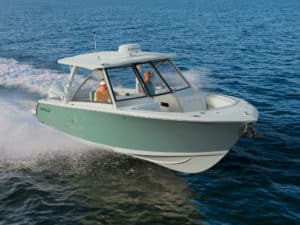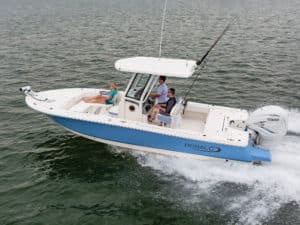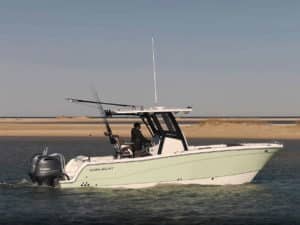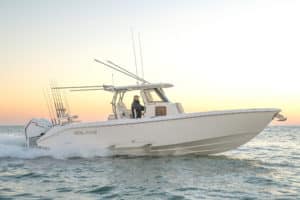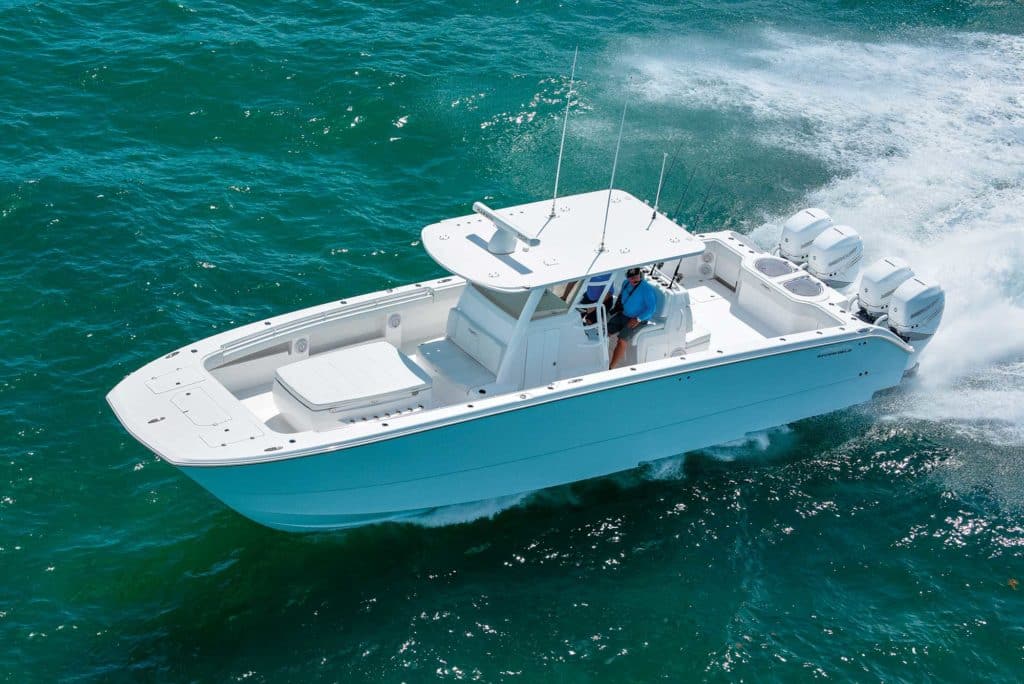
Power: Quad Mercury 350 Verados | Load: 400 gal. fuel, seven crew | Top Speed: 71 mph @ 6,400 rpm | Time to 30 mph: 8.7 sec. | Best MPG: 1 @ 33 mph (3,500 rpm) Hull
LOA: 40 ft. | Beam: 12 ft. | Transom Deadrise: NA | Dry Weight: 16,000 lb. (w/ engines) | Draft: 22 in. | Fuel: 630 gal. | Max Power: 1,600 hp | MSRP: $535,000 (base w/ four 350 Verados) More Information: invincibleboats.com Courtesy Invincible Boats
In my youth, sleep did not come easily on the night before a fishing trip. Now, decades later, on the eve of my Fish Trial of the Invincible 40 Catamaran, I felt the same nervous excitement.
The crew from Invincible Boats —Bill Cordes, Tim Gallagher, Jonathan Lipworth and Zack Powell — had hatched an ambitious plan to depart from Key West at sunrise bound for the Dry Tortugas some 60 miles due west, fish the deep ledges just south of this remote outpost, then return in the afternoon.
Such a trip often requires an overnight stay to provide sufficient fishing time, given the relatively long transit. But Team Invincible was bent on proving that one-day adventures to distant waters are imminently possible, provided you have the right boat. For this reason, an increasing number of anglers are considering big, powerful catamaran hulls, and Invincible is on the leading edge of the cat craze.
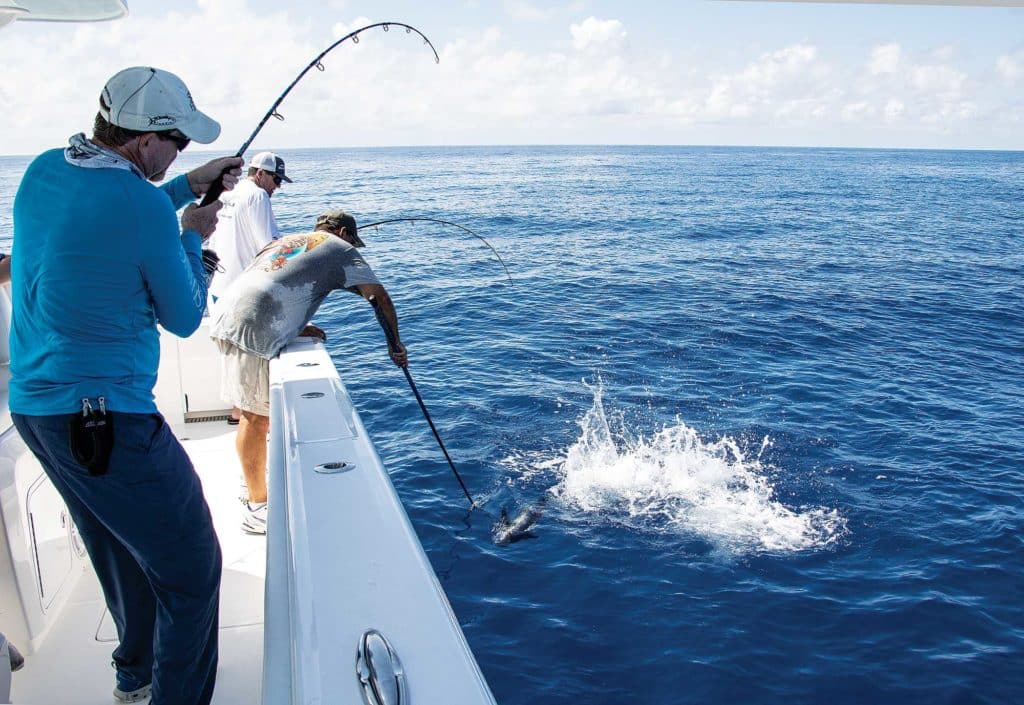
Room to Roam
As Sport Fishing Group Publisher Scott Salyers and I stepped aboard the 40 Cat in the gray light of dawn on that warm, clear morning in early June, I was immediately struck by the immense aft cockpit afforded by the 12-foot beam. Interior width measured more than 11 feet wide by 5 feet 4 inches long. Our crew of seven would have plenty of room to maneuver here without bumping into each other in the event that we experienced multiple hookups. (Spoiler alert: We did.)
Loaded with ice and provisions, we headed out from the marina at the Ocean’s Edge Resort on Stock Island. As we left the no-wake zone, Gallagher accelerated through the narrow, meandering channel. The 40 Cat banked gracefully inward while turning at speed.
Pete Morrelli of Morrelli & Melvin, the Newport Beach, California-based marine architectural firm that designed this running surface, credits the semi-asymmetrical cross-sectional design of each sponson for the comfortable handling. “This asymmetric shape allows the boat to lean inward while cornering, versus cat hulls with symmetric cross-sections that tend to turn flat or lean outward in turns,” Morrelli explains.
On the Atlantic side of Key West, Capt. Veach pointed toward his pinfish traps on a shallow flat. We idled into 2 feet of water to pick up the traps. The Cat easily floated and motored about in the shallows without touching bottom. With 26-inch-tall gunwales in the aft quarters, it was fairly easy to reach the traps using a short gaff. We transferred the bait into the twin pressurized 55-gallon transom livewells. We also used the 72-gallon livewell under the aft cockpit sole for several blue runners caught the day prior.
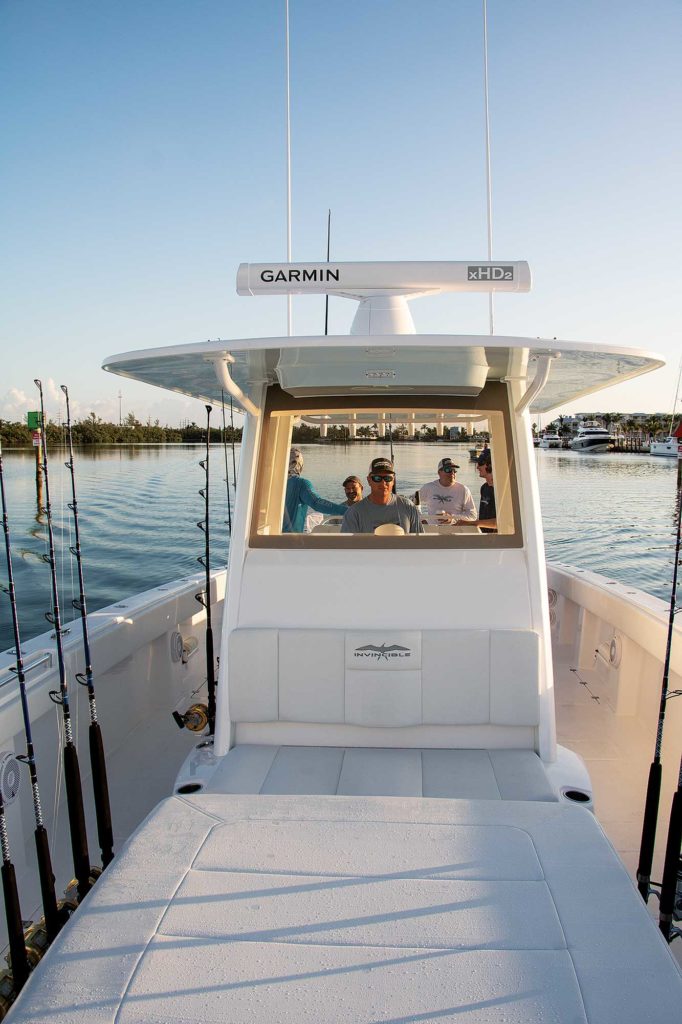
Dry Run
Gallagher motored out to deeper waters, turned the 40 Cat westward, and punched the throttles of the quad Mercury 350 Verado outboards. The double-stepped hull lifted onto plane quickly, and within 10 seconds reached a cruising speed of 55 mph at 5,000 rpm, where the quad 350s burned 60 gph for 0.91 mpg.
Using computational fluid-dynamic computer software, the design team at Morrelli & Melvin, which specializes in catamarans, tested lots of running surfaces before actually building this Invincible, Morrelli says. “This allowed us to refine the design of the twin steps to maximize speed and efficiency,” he explains. Morrelli & Melvin is one of the few firms that utilizes such software, which was originally developed by NASA, for recreational hull designs.
Calm winds and a slight west swell did not pose much of a challenge for this boat on test day. Yet as we crested the wakes of passing shrimp boats, I gained of sense of its seakeeping ability, which is different than that of a V-hull.
“Notice that there is very little bow‑to-stern rocking motion and virtually no deceleration when meeting the waves, as you might experience with a V-hull,” Gallagher points out. A pod between the sponsons helps split the water that rushes between the hulls to further soften the ride. All of this results in a high level of crew comfort, whether seated at the helm, in the aft foldout jump seats or in the forward console seat.
Twin flush-mounted Garmin GPSMap 8617 (17-inch) multifunction displays help guide the way offshore. The 40 Cat’s center console melds with the hardtop thanks to integral, powder-coated aluminum uprights, which frame the thick acrylic windshield and side windows that protect the helm.
My test boat came with a leaning-post-style helm seat with tackle stowage underneath and room for three people, but you can option this boat with three-across bucket helm seats with fold-down armrests and flip-up bolsters. Abaft the helm seats is seating for three in an aft-facing bench.
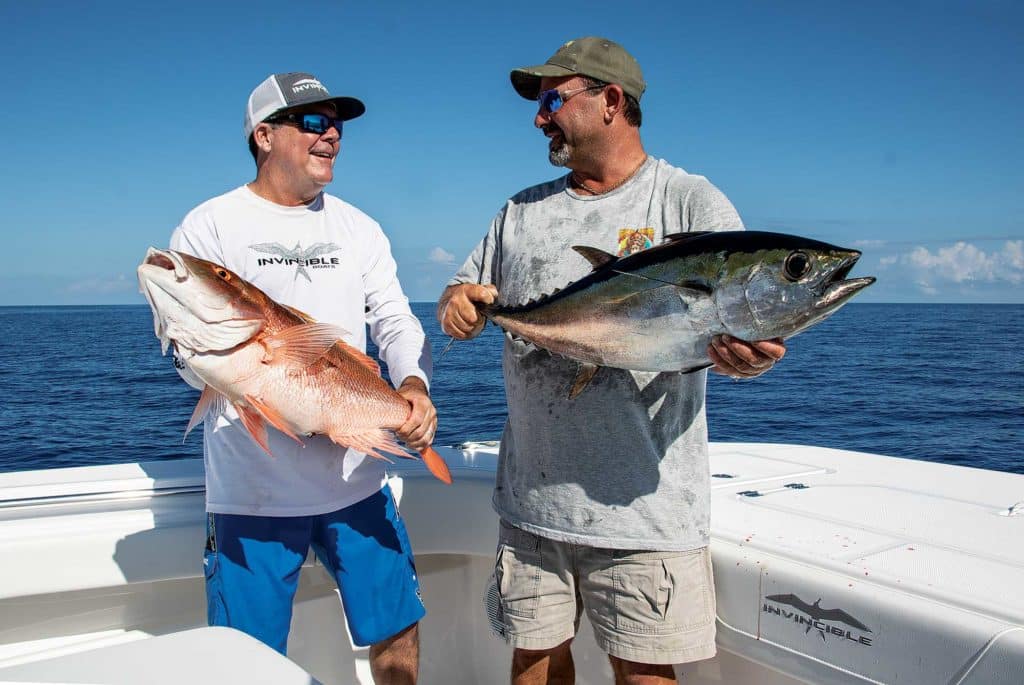
Time to Fish
We reached our first fishing spot — a hard-bottom ledge in 165 feet of water 60 miles from Key West — in a scant 80 minutes. With the historic Fort Jefferson barely visible to the north, Veach took over the helm to zero in on the hot spot. Powell walked forward to the massive anchor locker in the forepeak. The 40 Cat characteristically carries its wide beam all the way to the bow, and this affords plenty of foot room aside the console and the extra‑large coffin box on the foredeck.
The optional 960-quart coffin box is super wide with dividers inside to separate cold-storage items. Each side of the box is lined with seven vertical rod holders, and the top doubles as a padded lounger.
Just minutes after the boat settled back on the anchor, I was hooked up. As I battled the fish, I appreciated the coaming pads that completely encircled the interior to cushion my legs. A 15-pound mutton snapper soon rose from the depths and was deposited on ice. The 40 Cat has plenty of room to keep fish: two fish boxes below the aft cockpit — 268 gallons to starboard and 414 gallons to port — and two 158-gallon boxes forward. I also found two 8-foot-long dry lockers forward.
The action accelerated throughout the morning; nonstop catching highlighted by a number of multiple hookups. From amberjack, black grouper and blackfin tuna to kingfish, mahi and mutton snapper, this deep ledge produced a cornucopia of game species.
After three hours, we experienced a slight lull in the action, and Veach decided to try a new spot in 170 feet of water about 2 miles from the first. While en route, we cleaned up the deck using the freshwater washdown (there’s also a raw-water washdown) fed by an 82-gallon freshwater capacity. Veach quickly found the second spot using the Garmin GSD26 chirp fish finder, and action turned full speed again for another three hours.
Read Next: Invincible 40 Catamaran: 2018 Boat Buyers Guide
Numbers Game
By 3 p.m., everyone’s arms were too sore to pull on any more fish, and so we headed back. By 4:15 p.m., we were off Key West, where we paused to collect performance data on the cat with the real-world load of seven crewmembers, 400 gallons of fuel, 45 gallons of fresh water, 500 pounds of fish, 300 pounds of ice, and 180 pounds of livewell water. Even with this load, the four Verado 350s propelled the 40 Cat to 30 mph in 8.7 seconds and rocketed to a top speed of 71 mph at 6,400 rpm, while burning 138 gph for 0.51 mpg.
Best fuel efficiency occurred at 3,500 rpm and 33 mph, where the quad outboards burned 32 gph for slightly over 1 mpg, resulting in a cruising range of more than 600 miles.
However, as indicated earlier, the beauty of this boat lies in its ability to reach distant fishing spots quickly and return home the same day. So you’ll probably want to run well above the 33 mph, up toward 55 or 60 mph.
If the prospect of such trips keeps you up at night with nervous excitement, perhaps you need to think seriously about adopting this big, fast cat.

